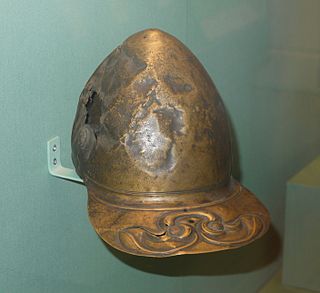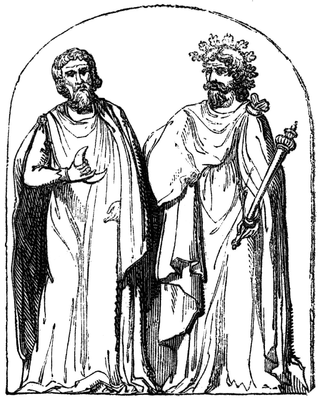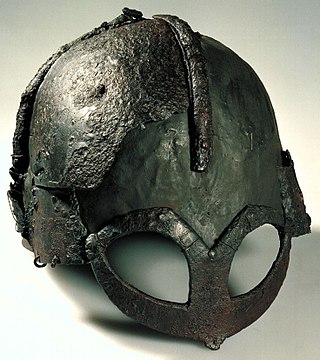
The La Tène culture was a European Iron Age culture. It developed and flourished during the late Iron Age, succeeding the early Iron Age Hallstatt culture without any definite cultural break, under considerable Mediterranean influence from the Greeks in pre-Roman Gaul, the Etruscans, and the Golasecca culture, but whose artistic style nevertheless did not depend on those Mediterranean influences.

A torc, also spelled torq or torque, is a large rigid or stiff neck ring in metal, made either as a single piece or from strands twisted together. The great majority are open at the front, although some have hook and ring closures and a few have mortice and tenon locking catches to close them. Many seem designed for near-permanent wear and would have been difficult to remove.

The British Iron Age is a conventional name used in the archaeology of Great Britain, referring to the prehistoric and protohistoric phases of the Iron Age culture of the main island and the smaller islands, typically excluding prehistoric Ireland, which had an independent Iron Age culture of its own. The Iron Age is not an archaeological horizon of common artefacts but is rather a locally-diverse cultural phase.

Prehistoric Wales in terms of human settlements covers the period from about 230,000 years ago, the date attributed to the earliest human remains found in what is now Wales, to the year AD 48 when the Roman army began a military campaign against one of the Welsh tribes. Traditionally, historians have believed that successive waves of immigrants brought different cultures into the area, largely replacing the previous inhabitants, with the last wave of immigrants being the Celts. However, studies of population genetics now suggest that this may not be true, and that immigration was on a smaller scale.

Ancient Celtic warfare refers to the historical methods of warfare employed by various Celtic people and tribes from Classical antiquity through the Migration period.

Ulcombe is a village near the town of Maidstone in Kent, England. The name is recorded in the Domesday Book and is thought to derive from 'Owl-coomb': 'coomb' meaning 'a deep little wooded valley; a hollow in a hill side' in Old English. The original deserted Medieval village site lies to the east of the parish church in a valley. There is also a water-mill below this site, probably of early origins. It stands below the Greensand Way.

The Sutton Hoo helmet is a decorated Anglo-Saxon helmet found during a 1939 excavation of the Sutton Hoo ship-burial. It was buried around the years c. 620–625 CE and is widely associated with an Anglo-Saxon leader, King Rædwald of East Anglia; its elaborate decoration may have given it a secondary function akin to a crown. The helmet was both a functional piece of armour that would have offered considerable protection if ever used in warfare, and a decorative, prestigious piece of extravagant metalwork. An iconic object from an archaeological find hailed as the "British Tutankhamen", it has become a symbol of the Early Middle Ages, "of Archaeology in general", and of England.
The archaeology of Anglo-Saxon England is the study of the archaeology of England from the 5th century AD to the 11th century, when it was ruled by Germanic tribes known collectively as the Anglo-Saxons.

The Crosby Garrett Helmet is a copper alloy Roman cavalry helmet dating from the late 2nd or early 3rd century AD. It was found by an unnamed metal detectorist near Crosby Garrett in Cumbria, England, in May 2010. Later investigations found that a Romano-British farming settlement had occupied the site where the helmet was discovered, which was located a few miles away from a Roman road and a Roman army fort. It is possible that the owner of the helmet was a local inhabitant who had served with the Roman cavalry.

The Waterloo Helmet is a pre-Roman Celtic bronze ceremonial horned helmet with repoussé decoration in the La Tène style, dating to circa 150–50 BC, that was found in 1868 in the River Thames by Waterloo Bridge in London, England. It is now on display at the British Museum in London.

The Meyrick Helmet is an Iron Age bronze peaked helmet, with La Tène style decoration, that is held at the British Museum in London. It is one of only four Iron Age helmets to have been discovered in Britain, the other three being the more famous Waterloo Helmet, the Canterbury Helmet and the North Bersted Warrior helmet. Unlike the Waterloo Helmet, which bears two cone-shaped horns, the Meyrick Helmet is hornless and appears to be based on a Roman model. Vincent Megaw, emeritus professor of archaeology at the University of Leicester, has conjectured that the helmet may have belonged to a British auxiliary fighting in the Roman army during the campaigns against the Brigantes in AD 71–74.

The appearance of Celts in Western Romania can be traced to the later La Tène period . Excavation of the great La Tène necropolis at Apahida, Cluj County, by S. Kovacs at the turn of the 20th century revealed the first evidence of Celtic culture in Romania. The 3rd–2nd century BC site is remarkable for its cremation burials and chiefly wheel-made funeral vessels.

Eddington was a village in Kent, South East England to the south-east of Herne Bay, to the west of Beltinge and to the north of Herne. It is now a suburb of Herne Bay, in Greenhill and Eddington Ward, one of the five wards of Herne Bay. Its main landmark for over 100 years until 2010 was Herne Bay Court, a former school which once possessed one of the largest and best-equipped school engineering workshops in England; it later became a Christian conference centre.

A druid was a member of the high-ranking priestly class in ancient Celtic cultures. Druids were religious leaders as well as legal authorities, adjudicators, lorekeepers, medical professionals and political advisors. Druids left no written accounts. While they were reported to have been literate, they are believed to have been prevented by doctrine from recording their knowledge in written form. Their beliefs and practices are attested in some detail by their contemporaries from other cultures, such as the Romans and the Greeks.
The year 2012 in archaeology involved some significant events.

The Shorwell helmet is an Anglo-Saxon helmet from the early to mid-sixth century AD found near Shorwell on the Isle of Wight in southern England. It was one of the grave goods of a high-status Anglo-Saxon warrior, and was found with other objects such as a pattern-welded sword and hanging bowl. One of only six known Anglo-Saxon helmets, alongside those found at Benty Grange (1848), Sutton Hoo (1939), Coppergate (1982), Wollaston (1997), and Staffordshire (2009), it is the sole example to derive from the continental Frankish style rather than the contemporaneous Northern "crested helmets" used in England and Scandinavia.

The Gjermundbu helmet is a Viking Age helmet.

The Deal Warrior, also known as the Mill Hill Warrior, is an Iron Age burial uncovered in Grave 112 at Mill Hill near Deal, Kent in 1988 by Dover Archaeological Group. It is well known for being suggested as the grave of a druid due to containing an almost-unique bronze headdress.

The Hellvi helmet eyebrow is a decorative eyebrow from a Vendel Period helmet. It comprises two fragments; the arch is made of iron decorated with strips of silver, and terminates in a bronze animal head that was cast on. The eyebrow was donated to the Statens historiska museum in November 1880 along with several other objects, all said to be from a grave find in Gotland, Sweden.
Julia Farley is a British archaeologist specialising in Iron Age and Roman metalwork. She is the Curator of the European Iron Age & Roman Conquest Period collections at the British Museum.















